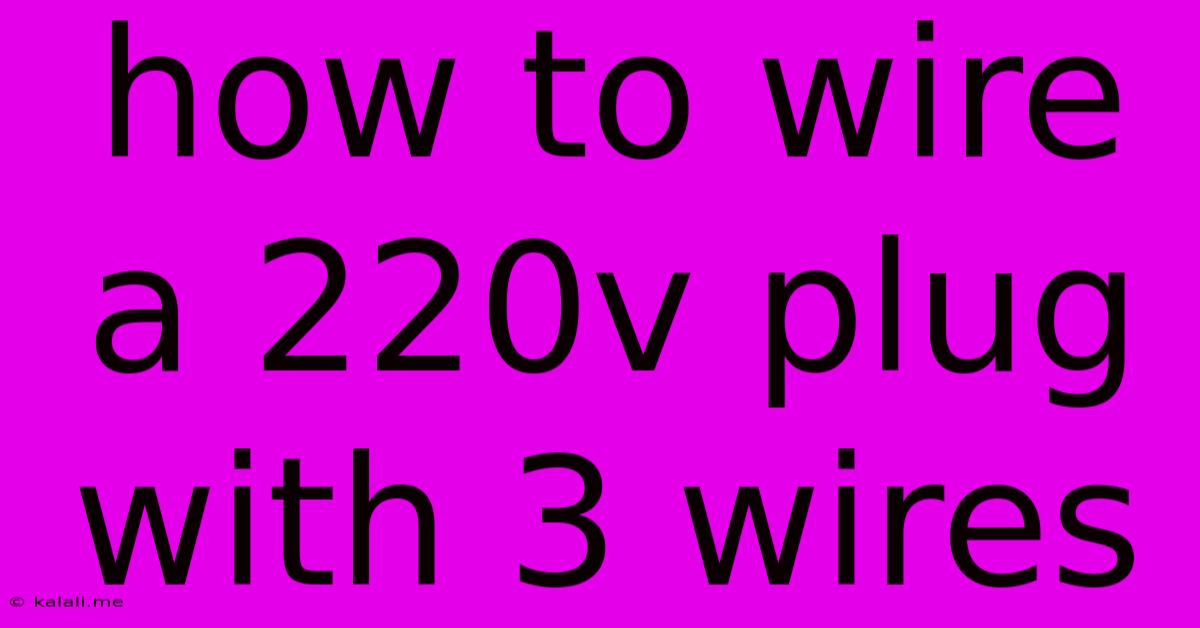How To Wire A 220v Plug With 3 Wires
Kalali
Jun 01, 2025 · 3 min read

Table of Contents
How to Wire a 220V Plug with Three Wires: A Comprehensive Guide
Meta Description: Wiring a 220V three-wire plug can seem daunting, but this comprehensive guide breaks down the process step-by-step, ensuring safety and correct connection. Learn about wire identification, plug components, and crucial safety precautions.
Wiring a 220V plug with three wires might seem intimidating, but with the right knowledge and careful execution, it’s a manageable task. This guide provides a detailed walkthrough, emphasizing safety and clarity. Remember, working with electricity can be dangerous. If you're unsure at any point, consult a qualified electrician.
Understanding 220V Three-Wire Systems
A 220V three-wire system typically consists of two hot wires (carrying the voltage), a neutral wire (completing the circuit), and a ground wire (for safety). Understanding the color codes of these wires is crucial. While variations exist, common color codes include:
- Black or Red: Hot Wire 1
- White or Red: Hot Wire 2 (Sometimes a different color is used to avoid confusion)
- Green or Bare Copper: Ground Wire
- White: Neutral Wire
Note: Always double-check your wiring and consult local electrical codes to confirm the color coding in your specific region. Incorrect wiring can lead to electrical hazards and damage to equipment.
Tools and Materials You'll Need
Before you begin, gather the following:
- 220V Three-Wire Plug: Choose a plug rated for the amperage of your appliance.
- Wire Strippers/Cutters: To prepare the wires for connection.
- Screwdrivers: Phillips and flathead, depending on your plug's screw type.
- Electrical Tape: To insulate connections and prevent shorts.
- Wire Connectors (Optional): For added security and easier connection, especially with thicker wires.
- Voltage Tester: To verify the absence of power before and after working on the wiring.
Step-by-Step Wiring Instructions
-
Power OFF: The most critical step! Turn off the power to the circuit at the breaker box. Use a voltage tester to confirm the power is off before proceeding.
-
Prepare the Wires: Strip approximately ½ inch of insulation from the end of each wire using the wire strippers. Be careful not to nick the copper wire itself.
-
Identify the Wires: Confirm the color codes of your wires against the standard color codes mentioned earlier. This is vital to prevent incorrect connections.
-
Connect to the Plug Terminals: Most 220V plugs have clearly labeled terminals. Connect the wires as follows:
- Hot Wire 1 (Black/Red): Connect to the terminal marked "L1" or a similar designation.
- Hot Wire 2 (White/Red): Connect to the terminal marked "L2" or a similar designation.
- Neutral Wire (White): Connect to the terminal marked "N" or "Neutral."
- Ground Wire (Green/Bare Copper): Connect to the terminal marked "G" or "Ground."
-
Tighten the Screws: Securely tighten all the terminal screws. Loose connections can lead to overheating and fire hazards.
-
Insulate the Connections (Optional): While the terminals usually provide sufficient insulation, wrapping electrical tape around the connections adds an extra layer of protection.
-
Test the Connection (Optional): Once complete, you can (carefully!) use a multimeter to confirm the correct voltage between the hot wires. However, this requires advanced electrical knowledge. It's best left to a professional unless you are very experienced.
-
Turn the Power ON: Carefully restore the power at the breaker box and test the plug's functionality with the appliance.
Safety Precautions
- Always turn off the power at the breaker box before working on any electrical wiring. This is the single most important safety precaution.
- Never work with wet hands or in wet conditions.
- Use appropriate safety equipment, such as insulated tools.
- If you are unsure about any aspect of this process, consult a qualified electrician. It’s better to be safe than sorry.
This guide provides a general overview. The specific steps might vary slightly depending on your plug's design and local electrical codes. Always prioritize safety and consult a professional if you are uncomfortable performing this task yourself.
Latest Posts
Latest Posts
-
Dimensions Of The Ark Of The Covenant
Jun 02, 2025
-
What Does It Mean That Jesus Died For Our Sins
Jun 02, 2025
-
What Is The Complementary Color Of Blue
Jun 02, 2025
-
What Happened To The Twins In The Witch
Jun 02, 2025
-
In Fried Green Tomatoes Is Ninny Idgie
Jun 02, 2025
Related Post
Thank you for visiting our website which covers about How To Wire A 220v Plug With 3 Wires . We hope the information provided has been useful to you. Feel free to contact us if you have any questions or need further assistance. See you next time and don't miss to bookmark.